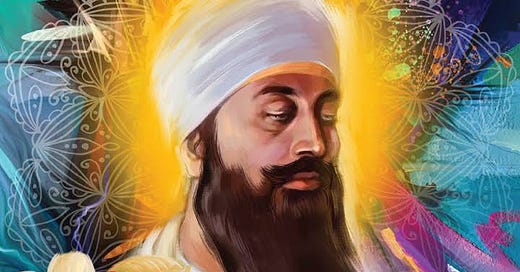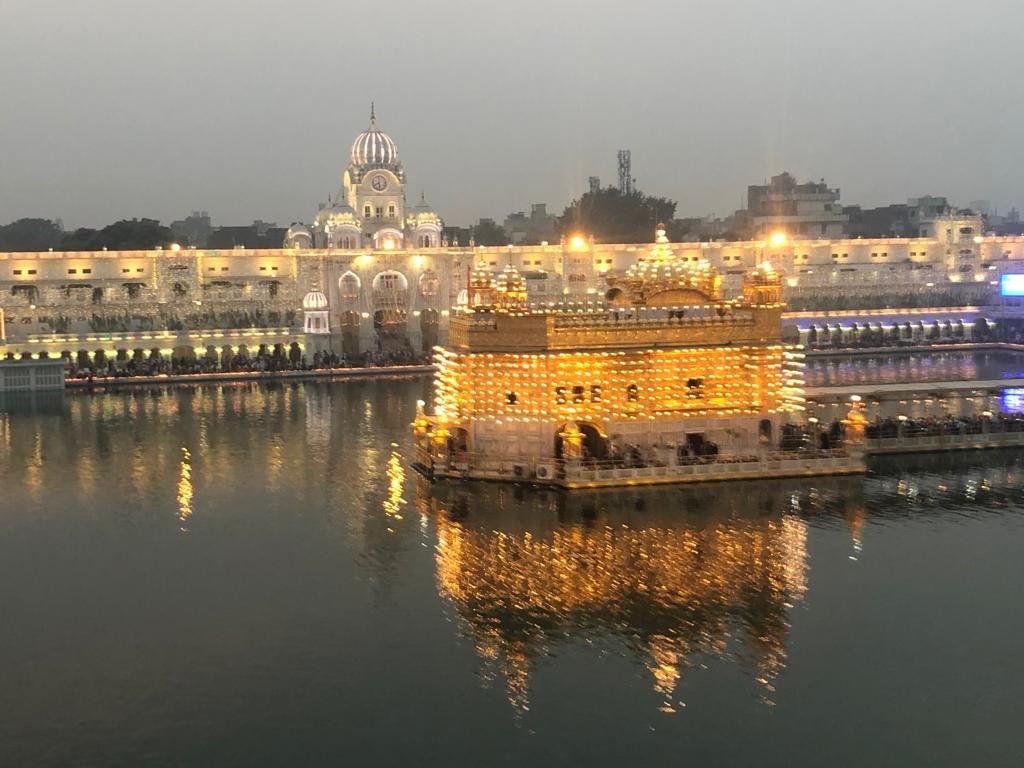Lord Ram in the Verses of Sri Guru Teg Bahadur
Bridging Divinity: From Ayodhya's Ram Mandir to Guru Teg Bahadur's Universal Wisdom.
The Consecration of Ram Mandir: A Momentous Moment of Spiritual Unity
On the auspicious day of January 22, 2024, at 12:20 PM IST, the world will celebrate the consecration of the Ram Mandir at Ayodhya during the sacred "Abhijeet Mahurat." This event is more than a once-in-a-millennium milestone for the Hindus worldwide; it symbolizes profound spiritual unity among people, reflecting the universal truths present in various beliefs and traditions. This momentous occasion offers a perfect opportunity for reflection on the sacred verses of Sri Guru Teg Bahadur Ji, the ninth Sikh Guru, as enshrined in the Sri Guru Granth Sahib (Ang 631). In these verses, he urges devotion to and contemplation of Lord Ram, perceived as the divine metaphor for the Almighty— omniscient and omnipotent God, the Akaal Purakh. These teachings, emphasizing harmony and unity, deeply resonate across different spiritual journeys.
Guru Gobind Singh Recompiles Sri Guru Granth Sahib
Before reflecting on the profound verses composed by Sri Guru Teg Bahadur Ji, revered as "Hind di Chadar," we delve very briefly into a significant chapter of Sikh history and spirituality. The ninth Nanak's contributions hold a special place in the Sikh scriptures, particularly in the context of the evolution of Sri Guru Granth Sahib's. This sacred scripture, initially compiled by the fifth Sikh Guru, Sri Guru Arjan Dev Ji, as the Adi Granth, underwent a crucial phase of recompilation under Guru Gobind Singh Ji. Amidst tumultuous times, when Guru Gobind Singh Ji had to leave Anandpur Sahib for Chamkaur Sahib, various 'beeds' of the scripture were lost in the Sirsa River. Later, at Talwandi Sabo, also known as Damdama Sahib, Guru Gobind Singh Ji painstakingly recompiled the entire scripture. In this final version, he included the verses penned by his father, Sri Guru Teg Bahadur Ji, thereby enriching the spiritual tapestry of the Sikh faith.
Verses of ਮਹਲਾ ੯ (Ninth Mehl) Sri Guru Granth Sahib
Salok Mehl 9, therefore, stands not just as a testament to the spiritual depth of the ninth Sikh Guru but also reflects the explicit endorsement of Guru Gobind Singh Ji, who significantly chose not to include his own verses in the Sri Guru Granth Sahib (his compositions form a separate text, the Dasam Granth). This decision underlines the unique reverence and status accorded to Sri Guru Granth Sahib, which is seen as the living embodiment of the Guru, a guiding light that continues to illuminate the path of millions of Sikhs worldwide. The teachings of Guru Teg Bahadur Ji, encapsulated in these verses, transcend time and space, offering universal wisdom and a path to spiritual awakening that is as relevant today as it was centuries ago.
Gurmukhi and Hindi and English Transliteration and transalation
Let's delve into a line-by-line presentation of the selected verse from Ang 631 of Sri Guru Granth Sahib, composed by Sri Guru Teg Bahadur Ji. This will include the original text in Gurmukhi (the script used for Punjabi), its transliteration in Hindi, the English transliteration, and finally, the English translation.
ਸੋਰਠਿ ਮਹਲਾ ੯ (सोरठि महला ९)
Soraṯẖ mėhlā 9 Sorat'h, Ninth Mehl:
ੴ ਸਤਿਗੁਰ ਪ੍ਰਸਾਦਿ ॥ (ੴ सतिगुर प्रसादि ॥)
Ik▫oaʼnkār saṯgur parsāḏ.
One Universal Creator God. By The Grace Of The True Guru:
ਰੇ ਮਨ ਰਾਮ ਸਿਉ ਕਰਿ ਪ੍ਰੀਤਿ ॥ (रे मन राम सिउ करि प्रीति ॥)
Re man rām si▫o kar parīṯ.
O mind, love the Lord.
ਸ੍ਰਵਨ ਗੋਬਿੰਦ ਗੁਨੁ ਸੁਨਉ ਅਰੁ ਗਾਉ ਰਸਨਾ ਗੀਤਿ ॥੧॥ ਰਹਾਉ ॥ (स्रवन गोबिंद गुनु सुनउ अरु गाउ रसना गीति ॥१॥ रहाउ ॥)
Sarvan gobinḏ gun sun▫o ar gā▫o rasnā gīṯ. ||1|| rahā▫o.
With your ears, hear the Glorious Praises of the Lord of the Universe, and with your tongue, sing His song. ||1||Pause||
ਕਰਿ ਸਾਧਸੰਗਤਿ ਸਿਮਰੁ ਮਾਧੋ ਹੋਹਿ ਪਤਿਤ ਪੁਨੀਤ ॥ (करि साधसंगति सिमरु माधो होहि पतित पुनीत ॥)
Kar sāḏẖsangaṯ simar māḏẖo hohi paṯiṯ punīṯ.
Join the Saadh Sangat, the Company of the Holy, and meditate in remembrance on the Lord; even a sinner like yourself will become pure.
ਕਾਲੁ ਬਿਆਲੁ ਜਿਉ ਪਰਿਓ ਡੋਲੈ ਮੁਖੁ ਪਸਾਰੇ ਮੀਤ ॥੧॥ (कालु बिआलु जिउ परिओ डोलै मुखु पसारे मीत ॥१॥)
Kāl bi▫āl ji▫o pari▫o dolai mukẖ pasāre mīṯ. ||1||
Death is on the prowl, with its mouth wide open, friend. ||1||
ਆਜੁ ਕਾਲਿ ਫੁਨਿ ਤੋਹਿ ਗ੍ਰਸਿ ਹੈ ਸਮਝਿ ਰਾਖਉ ਚੀਤਿ ॥ (आजु कालि फुनि तोहि ग्रसि है समझि राखउ चीति ॥)
Āj kāl fun ṯohi garas hai samajẖ rākẖa▫o cẖīṯ.
Today or tomorrow, eventually it will seize you; understand this in your consciousness.
ਕਹੈ ਨਾਨਕੁ ਰਾਮੁ ਭਜਿ ਲੈ ਜਾਤੁ ਅਉਸਰੁ ਬੀਤ ॥੨॥੧॥ (कहै नानकु रामु भजि लै जातु अउसरु बीत ॥२॥१॥
Kahai Nānak rām bẖaj lai jāṯ a▫osar bīṯ. ||2||1||
Says Nanak, meditate, and vibrate upon the Lord; this opportunity is slipping away! ||2||1||
Line by Line Analysis:
ੴ ਸਤਿਗੁਰ ਪ੍ਰਸਾਦਿ ॥ (ੴ सतिगुर प्रसादि ॥) This line establishes the core Sikh belief in one universal creator, attainable through the grace of the true Guru. It sets the tone for a deep connection with the Divine, transcending religious divides.
ਰੇ ਮਨ ਰਾਮ ਸਿਉ ਕਰਿ ਪ੍ਰੀਤਿ ॥ (रे मन राम सिउ करि प्रीति ॥) Here, Guru Ji addresses the human mind, urging it to cultivate love for the Lord. The use of 'Ram' symbolizes the universal God, not confined to any single form or faith.
ਸ੍ਰਵਨ ਗੋਬਿੰਦ ਗੁਨੁ ਸੁਨਉ ਅਰੁ ਗਾਉ ਰਸਨਾ ਗੀਤਿ ॥੧॥ ਰਹਾਉ ॥ (स्रवन गोबिंद गुनु सुनउ अरु गाउ रसना गीति ॥१॥ रहाउ ॥) This line emphasizes the importance of absorbing and vocalizing the divine qualities, suggesting an active engagement in spiritual practice.
ਕਰਿ ਸਾਧਸੰਗਤਿ ਸਿਮਰੁ ਮਾਧੋ ਹੋਹਿ ਪਤਿਤ ਪੁਨੀਤ ॥ (करि साधसंगति सिमरु माधो होहि पतित पुनीत ॥) Guru Ji advises seeking the company of the holy and meditating on the Divine. This transforms even the sinner into the pure, highlighting the transformative power of divine association.
ਕਾਲੁ ਬਿਆਲੁ ਜਿਉ ਪਰਿਓ ਡੋਲੈ ਮੁਖੁ ਪਸਾਰੇ ਮੀਤ ॥੧॥ (कालु बिआलु जिउ परिओ डोलै मुखु पसारे मीत ॥१॥)A stark reminder of the ever-looming presence of death, urging awareness and spiritual preparedness.
ਆਜੁ ਕਾਲਿ ਫੁਨਿ ਤੋਹਿ ਗ੍ਰਸਿ ਹੈ ਸਮਝਿ ਰਾਖਉ ਚੀਤਿ ॥ (आजु कालि फुनि तोहि ग्रसि है समझि राखउ चीति ॥) This line implores one to remain cognizant of the inevitable nature of death, reinforcing the urgency to turn towards the Divine.
ਕਹੈ ਨਾਨਕੁ ਰਾਮੁ ਭਜਿ ਲੈ ਜਾਤੁ ਅਉਸਰੁ ਬੀਤ ॥੨॥੧॥ (कहै नानकु रामु भजि लै जातु अउसरु बीत ॥२॥१॥ Finally, Guru Ji concludes by emphasizing the fleeting nature of life and the importance of seizing the moment to remember God.
Delving Deeper into Salok Mehl 9: A Reflection on Life's Impermanence
Salok Mehl 9, composed by Guru Teg Bahadur Ji and set in the melodious Raag Sorath, is a profound spiritual anthem that transcends religious boundaries, urging an immediate and heartfelt connection with the Divine. The essence of these verses lies in their universal message: the importance of embracing divine remembrance, seeking the company of the virtuous, and recognizing the fleeting nature of human existence.
Raag Sorath, known for its soothing yet profound impact, perfectly complements the introspective nature of these verses. It enhances the emotional depth of Guru Teg Bahadur Ji’s words, encouraging the listener to reflect deeply on life’s fragile and transient nature.
The verses poignantly remind us that death can arrive at any moment, making it crucial not to delay or squander time but to continuously engage in the contemplation of the Divine. Guru Teg Bahadur Ji's message is clear: embrace the present moment for spiritual contemplation and connection with the Divine. This timeless wisdom serves as a reminder of life’s impermanence and the importance of focusing on spiritual pursuits amidst the uncertainties of the world.
The Universal Resonance of Lord Ram
In Sikhism, the name 'Ram' is often used as a metaphor for the Almighty, omnipotent and omniscient God – the Akaal Purakh. This interpretation resonates with the way Lord Ram is revered across different faiths: as the Son of Maharaja Dashrath, an incarnation of Lord Vishnu, or a symbol of the Divine. The name of Lord Ram, thus, reverberates across humanity, transcending traditional religious barriers.
Embracing Unity and Spirituality on the Auspicious Day
As we draw near to the auspicious day of January 22, let us imbibe the wisdom of Sri Guru Teg Bahadur Ji's profound verses. They poignantly remind us of the transient nature of our existence and the ever-looming presence of death. These verses offer a call to unity and inclusivity, urging us to transcend our trivial disputes and ego-driven squabbles. They encourage us to rise above the confines of our individual beliefs, and collectively pursue a path of spiritual enlightenment and divine love. In doing so, we reach out to the Omnipotent God, embracing a journey that harmonizes our spirits with the universal essence of divinity. This approach fosters a deeper understanding and respect for the diverse paths that lead to the same eternal truth.







